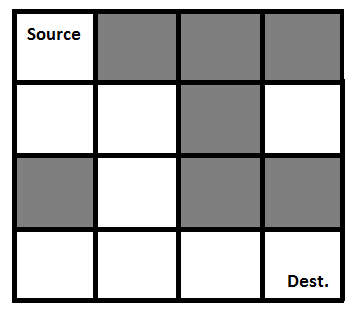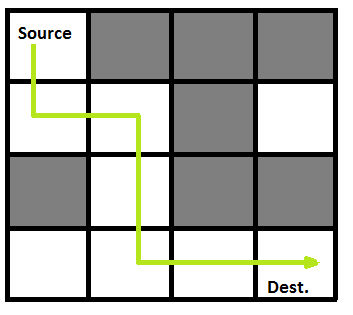Rat in a Maze
We have discussed Backtracking and Knight’s tour problem in Set 1. Let us discuss Rat in a Maze as another example problem that can be solved using Backtracking.
A Maze is given as N*N binary matrix of blocks where source block is the upper left most block i.e., maze[0][0] and destination block is lower rightmost block i.e., maze[N-1][N-1]. A rat starts from source and has to reach the destination. The rat can move only in two directions: forward and down.
In the maze matrix, 0 means the block is a dead end and 1 means the block can be used in the path from source to destination. Note that this is a simple version of the typical Maze problem. For example, a more complex version can be that the rat can move in 4 directions and a more complex version can be with a limited number of moves.
Following is an example maze.
Following is binary matrix representation of the above maze.
{1, 0, 0, 0}
{1, 1, 0, 1}
{0, 1, 0, 0}
{1, 1, 1, 1}
Following is a maze with highlighted solution path.
Following is the solution matrix (output of program) for the above input matrx.
{1, 0, 0, 0}
{1, 1, 0, 0}
{0, 1, 0, 0}
{0, 1, 1, 1}
All enteries in solution path are marked as 1.
Naive Algorithm
The Naive Algorithm is to generate all paths from source to destination and one by one check if the generated path satisfies the constraints.
while there are untried paths
{
generate the next path
if this path has all blocks as 1
{
print this path;
}
}
Backtracking Algorithm
If destination is reached
print the solution matrix
Else
a) Mark current cell in solution matrix as 1.
b) Move forward in the horizontal direction and recursively check if this
move leads to a solution.
c) If the move chosen in the above step doesn't lead to a solution
then move down and check if this move leads to a solution.
d) If none of the above solutions works then unmark this cell as 0
(BACKTRACK) and return false.
Implementation of Backtracking solution
C/C++
/* C/C++ program to solve Rat in a Maze problem using
backtracking */
#include<stdio.h>
// Maze size
#define N 4
bool solveMazeUtil(int maze[N][N], int x, int y, int sol[N][N]);
/* A utility function to print solution matrix sol[N][N] */
void printSolution(int sol[N][N])
{
for (int i = 0; i < N; i++)
{
for (int j = 0; j < N; j++)
printf(" %d ", sol[i][j]);
printf("\n");
}
}
/* A utility function to check if x,y is valid index for N*N maze */
bool isSafe(int maze[N][N], int x, int y)
{
// if (x,y outside maze) return false
if(x >= 0 && x < N && y >= 0 && y < N && maze[x][y] == 1)
return true;
return false;
}
/* This function solves the Maze problem using Backtracking. It mainly
uses solveMazeUtil() to solve the problem. It returns false if no
path is possible, otherwise return true and prints the path in the
form of 1s. Please note that there may be more than one solutions,
this function prints one of the feasible solutions.*/
bool solveMaze(int maze[N][N])
{
int sol[N][N] = { {0, 0, 0, 0},
{0, 0, 0, 0},
{0, 0, 0, 0},
{0, 0, 0, 0}
};
if(solveMazeUtil(maze, 0, 0, sol) == false)
{
printf("Solution doesn't exist");
return false;
}
printSolution(sol);
return true;
}
/* A recursive utility function to solve Maze problem */
bool solveMazeUtil(int maze[N][N], int x, int y, int sol[N][N])
{
// if (x,y is goal) return true
if(x == N-1 && y == N-1)
{
sol[x][y] = 1;
return true;
}
// Check if maze[x][y] is valid
if(isSafe(maze, x, y) == true)
{
// mark x,y as part of solution path
sol[x][y] = 1;
/* Move forward in x direction */
if (solveMazeUtil(maze, x+1, y, sol) == true)
return true;
/* If moving in x direction doesn't give solution then
Move down in y direction */
if (solveMazeUtil(maze, x, y+1, sol) == true)
return true;
/* If none of the above movements work then BACKTRACK:
unmark x,y as part of solution path */
sol[x][y] = 0;
return false;
}
return false;
}
// driver program to test above function
int main()
{
int maze[N][N] = { {1, 0, 0, 0},
{1, 1, 0, 1},
{0, 1, 0, 0},
{1, 1, 1, 1}
};
solveMaze(maze);
return 0;
}
Java
/* Java program to solve Rat in a Maze problem using
backtracking */
public class RatMaze
{
final int N = 4;
/* A utility function to print solution matrix
sol[N][N] */
void printSolution(int sol[][])
{
for (int i = 0; i < N; i++)
{
for (int j = 0; j < N; j++)
System.out.print(" " + sol[i][j] +
" ");
System.out.println();
}
}
/* A utility function to check if x,y is valid
index for N*N maze */
boolean isSafe(int maze[][], int x, int y)
{
// if (x,y outside maze) return false
return (x >= 0 && x < N && y >= 0 &&
y < N && maze[x][y] == 1);
}
/* This function solves the Maze problem using
Backtracking. It mainly uses solveMazeUtil()
to solve the problem. It returns false if no
path is possible, otherwise return true and
prints the path in the form of 1s. Please note
that there may be more than one solutions, this
function prints one of the feasible solutions.*/
boolean solveMaze(int maze[][])
{
int sol[][] = {{0, 0, 0, 0},
{0, 0, 0, 0},
{0, 0, 0, 0},
{0, 0, 0, 0}
};
if (solveMazeUtil(maze, 0, 0, sol) == false)
{
System.out.print("Solution doesn't exist");
return false;
}
printSolution(sol);
return true;
}
/* A recursive utility function to solve Maze
problem */
boolean solveMazeUtil(int maze[][], int x, int y,
int sol[][])
{
// if (x,y is goal) return true
if (x == N - 1 && y == N - 1)
{
sol[x][y] = 1;
return true;
}
// Check if maze[x][y] is valid
if (isSafe(maze, x, y) == true)
{
// mark x,y as part of solution path
sol[x][y] = 1;
/* Move forward in x direction */
if (solveMazeUtil(maze, x + 1, y, sol))
return true;
/* If moving in x direction doesn't give
solution then Move down in y direction */
if (solveMazeUtil(maze, x, y + 1, sol))
return true;
/* If none of the above movements works then
BACKTRACK: unmark x,y as part of solution
path */
sol[x][y] = 0;
return false;
}
return false;
}
public static void main(String args[])
{
RatMaze rat = new RatMaze();
int maze[][] = {{1, 0, 0, 0},
{1, 1, 0, 1},
{0, 1, 0, 0},
{1, 1, 1, 1}
};
rat.solveMaze(maze);
}
}
// This code is contributed by Abhishek Shankhadhar
Python3
# Python3 program to solve Rat in a Maze
# problem using backracking
# Maze size
N = 4
# A utility function to print solution matrix sol
def printSolution( sol ):
for i in sol:
for j in i:
print(str(j) + " ", end="")
print("")
# A utility function to check if x,y is valid
# index for N*N Maze
def isSafe( maze, x, y ):
if x >= 0 and x < N and y >= 0 and y < N and maze[x][y] == 1:
return True
return False
""" This function solves the Maze problem using Backtracking.
It mainly uses solveMazeUtil() to solve the problem. It
returns false if no path is possible, otherwise return
true and prints the path in the form of 1s. Please note
that there may be more than one solutions, this function
prints one of the feasable solutions. """
def solveMaze( maze ):
# Creating a 4 * 4 2-D list
sol = [ [ 0 for j in range(4) ] for i in range(4) ]
if solveMazeUtil(maze, 0, 0, sol) == False:
print("Solution doesn't exist");
return False
printSolution(sol)
return True
# A recursive utility function to solve Maze problem
def solveMazeUtil(maze, x, y, sol):
#if (x,y is goal) return True
if x == N - 1 and y == N - 1:
sol[x][y] = 1
return True
# Check if maze[x][y] is valid
if isSafe(maze, x, y) == True:
# mark x, y as part of solution path
sol[x][y] = 1
# Move forward in x direction
if solveMazeUtil(maze, x + 1, y, sol) == True:
return True
# If moving in x direction doesn't give solution
# then Move down in y direction
if solveMazeUtil(maze, x, y + 1, sol) == True:
return True
# If none of the above movements work then
# BACKTRACK: unmark x,y as part of solution path
sol[x][y] = 0
return False
# Driver program to test above function
if __name__ == "__main__":
# Initialising the maze
maze = [ [1, 0, 0, 0],
[1, 1, 0, 1],
[0, 1, 0, 0],
[1, 1, 1, 1] ]
solveMaze(maze)
# This code is contributed by Shiv Shankar
Output: The 1 values show the path for rat
1 0 0 0 1 1 0 0 0 1 0 0 0 1 1 1


